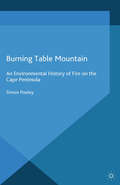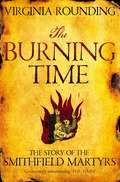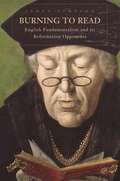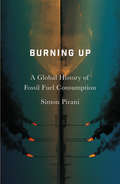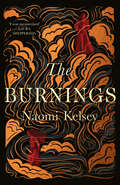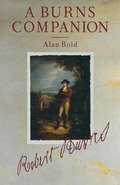- Table View
- List View
Burning Table Mountain: An Environmental History of Fire on the Cape Peninsula (Palgrave Studies in World Environmental History)
by S. PooleyCape Town's iconic Table Mountain and the surrounding peninsula has been a crucible for attempts to integrate the social and ecological dimensions of wild fire. This environmental history of humans and wildfire outlines these interactions from the practices of Khoikhoi herders to the conflagrations of January 2000. The region's unique, famously diverse fynbos vegetation has been transformed since European colonial settlement, through urbanisation and biological modifications, both intentional (forestry) and unintentional (biological invasions). In all the diverse visions people have formed for Table Mountain, aesthetic and utilitarian, fire has been regarded as a central problem. This book shows how scientific understandings of fire in fynbos developed slowly in the face of strong prejudices. Human impacts were intensified in the twentieth century, which provides the temporal focus for the book. The disjunctures between popular perception, expert knowledge, policy and management are explored, and the book supplements existing short-term scientific data with proxies on fire incidence trends recovered from historical records.
Burning the Big House: The Story of the Irish Country House in a Time of War and Revolution
by Terence DooleyThe gripping story of the tumultuous destruction of the Irish country house, spanning the revolutionary years of 1912 to 1923 During the Irish Revolution nearly three hundred country houses were burned to the ground. These “Big Houses” were powerful symbols of conquest, plantation, and colonial oppression, and were caught up in the struggle for independence and the conflict between the aristocracy and those demanding access to more land. Stripped of their most important artifacts, most of the houses were never rebuilt and ruins such as Summerhill stood like ghostly figures for generations to come. Terence Dooley offers a unique perspective on the Irish Revolution, exploring the struggles over land, the impact of the Great War, and why the country mansions of the landed class became such a symbolic target for republicans throughout period. Dooley details the shockingly sudden acts of occupation and destruction—including soldiers using a Rembrandt as a dart board—and evokes the exhilaration felt by the revolutionaries at seizing these grand houses and visibly overturning the established order.
Burning the Books
by Richard OvendenThe director of the famed Bodleian Libraries at Oxford narrates the global history of the willful destruction—and surprising survival—of recorded knowledge over the past three millennia.Libraries and archives have been attacked since ancient times but have been especially threatened in the modern era. Today the knowledge they safeguard faces purposeful destruction and willful neglect; deprived of funding, libraries are fighting for their very existence. Burning the Books recounts the history that brought us to this point.Richard Ovenden describes the deliberate destruction of knowledge held in libraries and archives from ancient Alexandria to contemporary Sarajevo, from smashed Assyrian tablets in Iraq to the destroyed immigration documents of the UK Windrush generation. He examines both the motivations for these acts—political, religious, and cultural—and the broader themes that shape this history. He also looks at attempts to prevent and mitigate attacks on knowledge, exploring the efforts of librarians and archivists to preserve information, often risking their own lives in the process.More than simply repositories for knowledge, libraries and archives inspire and inform citizens. In preserving notions of statehood recorded in such historical documents as the Declaration of Independence, libraries support the state itself. By preserving records of citizenship and records of the rights of citizens as enshrined in legal documents such as the Magna Carta and the decisions of the US Supreme Court, they support the rule of law. In Burning the Books, Ovenden takes a polemical stance on the social and political importance of the conservation and protection of knowledge, challenging governments in particular, but also society as a whole, to improve public policy and funding for these essential institutions.
Burning the Books: A History of Knowledge Under Attack
by Richard Ovenden'Burning the Books is fascinating, thought-provoking and very timely. No one should keep quiet about this library history' IAN HISLOPOpening with the notorious bonfires of 'un-German' and Jewish literature in 1933 that offered such a clear signal of Nazi intentions, Burning the Books takes us on a 3000-year journey through the destruction of knowledge and the fight against all the odds to preserve it. Richard Ovenden, director of the world-famous Bodleian Library, explains how attacks on libraries and archives have been a feature of history since ancient times but have increased in frequency and intensity during the modern era. Libraries are far more than stores of literature, through preserving the legal documents such as Magna Carta and records of citizenship, they also support the rule of law and the rights of citizens. Today, the knowledge they hold on behalf of society is under attack as never before. In this fascinating book, he explores everything from what really happened to the Great Library of Alexandria to the Windrush papers, from Donald Trump's deleting embarrassing tweets to John Murray's burning of Byron's memoirs in the name of censorship. At once a powerful history of civilisation and a manifesto for the vital importance of physical libraries in our increasingly digital age, Burning the Books is also a very human story animated by an unlikely cast of adventurers, self-taught archaeologists, poets, freedom-fighters -- and, of course, librarians and the heroic lengths they will go to preserve and rescue knowledge, ensuring that civilisation survives. From the rediscovery of the Dead Sea Scrolls in the desert, hidden from the Romans and lost for almost 2000 years to the medieval manuscript that inspired William Morris, the knowledge of the past still has so many valuable lessons to teach us and we ignore it at our peril.
Burning the Reichstag: An Investigation into the Third Reich's Enduring Mystery
by Benjamin Carter HettIn February 1933, Adolf Hitler had only a tenuous grasp on power. Chancellor of Germany for merely four weeks, he led a fragile coalition government. The Nazis had lost seats in the Reichstag in the recent election, and claimed only three of thirteen cabinet posts. Then on February 27th, arson sent the Reichstag, the home and symbol of German democracy, up in flames. Immediately blaming the Communists, Hitler's new government approved a decree that tore the heart out of the democratic constitution of the Weimar Republic and cancelled the rule of law. Five thousand people were immediately arrested. The Reichstag fire marked the true beginning of the Third Reich, which ruled for 12 more years. The controversy surrounding the fire's origins has endured for 80. In Burning the Reichstag, Benjamin Hett offers a gripping account of Hitler's rise to dictatorship-one that challenges orthodoxy and recovers the true significance of the part the fire played. At the scene the police arrested 23-year-old Marinus van der Lubbe, a Dutch Communist stonemason. Though he was initially dismissed abroad as a Nazi tool, post-war historians since the 1950s have largely judged him solely guilty-a lone arsonist exploited by Hitler. Hett's book reopens the case, providing vivid portraits of key figures, including Rudolf Diels, Hermann Goering, Joseph Goebbels, and the historian Fritz Tobias, whose account of the fire has, until now, been the standard. Making use of a number of new sources and archives, Hett sets the Reichstag fire in a wider context, revealing how and why it has remained one of the last mysteries of the Nazi period, and one of the most controversial and contested events in the 20th century.
Burning the Reichstag: An Investigation into the Third Reich's Enduring Mystery
by Benjamin Carter HettIn February 1933, Adolf Hitler had only a tenuous grasp on power. Chancellor of Germany for merely four weeks, he led a fragile coalition government. The Nazis had lost seats in the Reichstag in the recent election, and claimed only three of thirteen cabinet posts. Then on February 27th, arson sent the Reichstag, the home and symbol of German democracy, up in flames. Immediately blaming the Communists, Hitler's new government approved a decree that tore the heart out of the democratic constitution of the Weimar Republic and cancelled the rule of law. Five thousand people were immediately arrested. The Reichstag fire marked the true beginning of the Third Reich, which ruled for 12 more years. The controversy surrounding the fire's origins has endured for 80. In Burning the Reichstag, Benjamin Hett offers a gripping account of Hitler's rise to dictatorship-one that challenges orthodoxy and recovers the true significance of the part the fire played. At the scene the police arrested 23-year-old Marinus van der Lubbe, a Dutch Communist stonemason. Though he was initially dismissed abroad as a Nazi tool, post-war historians since the 1950s have largely judged him solely guilty-a lone arsonist exploited by Hitler. Hett's book reopens the case, providing vivid portraits of key figures, including Rudolf Diels, Hermann Goering, Joseph Goebbels, and the historian Fritz Tobias, whose account of the fire has, until now, been the standard. Making use of a number of new sources and archives, Hett sets the Reichstag fire in a wider context, revealing how and why it has remained one of the last mysteries of the Nazi period, and one of the most controversial and contested events in the 20th century.
The Burning Time: The Story of the Smithfield Martyrs
by Virginia RoundingSmithfield, settled on the fringes of Roman London, was once a place of revelry. Jesters and crowds flocked for the medieval St Bartholomew's Day celebrations, tournaments were plentiful and it became the location of London's most famous meat market. Yet in Tudor England, Smithfield had another, more sinister use: the public execution of heretics.Spanning the reigns of British history's most remarkable dynasty, The Burning Time is a vivid insight into an era in which what was orthodoxy one year might be dangerous heresy the next. The first martyrs were Catholics, who cleaved to Rome in defiance of Henry VIII's break with the papacy. But with the accession of Henry's daughter Mary - soon to be nicknamed 'Bloody Mary' - the charge of heresy was levelled against devout Protestants, who chose to burn rather than recant. At the centre of Virginia Rounding's vivid account of this extraordinary period are two very different characters. The first is Richard Rich, Thomas Cromwell's protégé, who, almost uniquely, remained in a position of great power, influence and wealth under three Tudor monarchs, and who helped send many devout men and women to their deaths. The second is John Deane, Rector of St Bartholomew's, who was able, somehow, to navigate the treacherous waters of changing dogma and help others to survive. The Burning Time is their story, but it is also the story of the hundreds of men and women who were put to the fire for their faith. It is a gripping insight into a time when people were willing to die, and to kill, in the name of religion.
Burning to Read: English Fundamentalism and Its Reformation Opponents
by James SimpsonAmid present-day conflagrations, this illuminating book reminds us of the sources, and profound consequences, of Christian fundamentalism in the sixteenth century. Simpson focuses on the cultural transformation in early modern England that allowed common people to read the Bible for the first time. The last wave of fundamentalist reading in the West provoked 150 years of violent upheaval; as we approach a second wave, this powerful book alerts us to our peril.
Burning Up: A Global History of Fossil Fuel Consumption
by Simon PiraniCoal, gas and oil have been capitalism's main fuels since the industrial revolution. And yet, of all the fossil fuels ever consumed, more than half were burned in the last 50 years. Most alarming of all, fossil fuel consumption has grown fastest in the last three decades, since scientists confirmed that it is the main cause of potentially devastating global warming.*BR**BR*In Burning Up, Simon Pirani recounts the history of fossil fuels' relentless rise since the mid twentieth century. Dispelling explanations foregrounding Western consumerism, and arguments that population growth is the main problem, Pirani shows how fossil fuels are consumed through technological, social and economic systems, and that these systems must change.*BR**BR*This is a major contribution to understanding the greatest crisis of our time.
The Burnings
by Naomi Kelsey‘I was mesmerised’ LAURA SHEPPERSON, Sunday Times bestselling author of The Heroines
Burnout, Fatigue, Exhaustion: An Interdisciplinary Perspective on a Modern Affliction
by Sighard Neckel Anna Katharina Schaffner Greta WagnerThis interdisciplinary book explores both the connections and the tensions between sociological, psychological, and biological theories of exhaustion. It examines how the prevalence of exhaustion – both as an individual experience and as a broader socio-cultural phenomenon – is manifest in the epidemic rise of burnout, depression, and chronic fatigue. It provides innovative analyses of the complex interplay between the processes involved in the production of mental health diagnoses, socio-cultural transformations, and subjective illness experiences. Using many of the existing ideologically charged exhaustion theories as case studies, the authors investigate how individual discomfort and wider social dynamics are interrelated. Covering a broad range of topics, this book will appeal to those working in the fields of psychology, sociology, medicine, psychiatry, literature, and history.
Burnout, Fatigue, Exhaustion: An Interdisciplinary Perspective on a Modern Affliction
by Sighard Neckel Anna Katharina Schaffner Greta WagnerThis interdisciplinary book explores both the connections and the tensions between sociological, psychological, and biological theories of exhaustion. It examines how the prevalence of exhaustion – both as an individual experience and as a broader socio-cultural phenomenon – is manifest in the epidemic rise of burnout, depression, and chronic fatigue. It provides innovative analyses of the complex interplay between the processes involved in the production of mental health diagnoses, socio-cultural transformations, and subjective illness experiences. Using many of the existing ideologically charged exhaustion theories as case studies, the authors investigate how individual discomfort and wider social dynamics are interrelated. Covering a broad range of topics, this book will appeal to those working in the fields of psychology, sociology, medicine, psychiatry, literature, and history.
A Burns Companion (Literary Companions)
by Alan BoldThis Companion, designed as an authoritative biographical and critical guide to Burns, is in six sections. Part I places Burns in context with a Chronology, 'The Burns Circle' and a Topography. Part II looks at the Burnsian issues of religion, politics, philosophy, drink, drama and sex. Part III an essay on Burns as a poetic phenomenon, is sure to provoke debate about the relevance of Burns to his time and ours. Part IV examines twenty-five poems, eighteen verse epistles and twenty-six songs as well as commenting on the letters, political ballads and Common Place Books. A Select Bibliography (Part V) and four Appendixes (Part VI) are followed by a glossary of Scots words, and index of poems and a general index.
The Burns Supper: A Comprehensive History
by Clark McGinnWhen did Burns Suppers start?Why is it celebrated all over the world?Who can join in the fun?Spanning the history of the phenomenon, from the year of its creation in 1801 to the present day, this book offers you everything you need to know about the Burns Supper, and the poet for whom it is held every year. From the origins of the custom to its modern day interpretations, from the rituals and traditions to the fun and fellowship, this first full-length study of the unique annual celebration of Scotland’s national poet answers every question you can think of, along with every one you can’t.
The Burns Supper: A Concise History
by Clark McGinnThis annual celebration of the life and works of the poet Robert Burns is held in Scotland and across the globe around the anniversary of the poet’s birthday in the form of a convivial dinner with particular, some may say peculiar, ritual traditions.When the Reverend Hamilton Paul agreed to arrange the first anniversary dinner for Robert Burns’ patrons and friends in July 1801, he began a tradition that quite soon became a global celebration.Over two hundred years later, Burns Suppers are held all over the world to commemorate the life and work of a poet beloved wherever people celebrate life, love and liberty. From its beginning with nine Scotsmen in Burns Cottage, to today, where over nine million people join in the Burns Supper festivities, from the USA to Russia, Australia to China, and somewhere near you. The long and happy story of Burns Night is explored in this history of the annual event which has been called ‘the biggest party in the world’.
Burnt Norton
by Caroline Sandon1731: When his youngest son is killed in a tragic accident, Sir William Keyt, master of Norton House, buries himself in his fortune. He builds a second vast mansion on his grounds, squandering money he does not have on luxury his family does not want. Keyt has long been blind to the desires of others. His eldest son has fallen in love with their young maidservant, Molly Johnson, a ray of light in a household dimmed by tragedy. Keyt wants Molly for himself and, driven mad with lust and jealousy, he will do anything to have her...
Burnt Out: How 'the Troubles' Began
by Michael McCannOn 14 August 1969, at the age of 14, Michael McCann and his family fled their home. Life changed totally for the McCanns and the entire nationalist community. Thousands of innocent people vacated their homes, driven out by the initial pogrom and then by the ongoing campaign of expulsion by loyalist violence and intimidation. The British army occupation and the continuing violence utterly devastated communities on a monumental scale. Burnt Out: How the Troubles Began, shows how the truth became one of the first casualties of the horrific events of August 1969. It examines the prominent role of state forces and the unionist government in the violence that erupted in Derry and Belfast and assesses how and why the violence began and generated three decades of subsequent brutality. Against a mountain of contrary evidence, many still choose to blame the violence on the commemoration of the Easter Rising in 1966 and the efforts of the nationalist community to defend themselves on two hellish August nights in the late summer of 1969. Burnt Out: How the Troubles Began, is essential reading for anybody interested in the outbreak and causes of ‘the Troubles’.
The Burnt-Out Town of Miracles
by Roy Jacobsen'A compact and compelling novel by an iconic Norwegian writer...[and] thanks to Don Bartlett and Don Shaw's crisp translation, we see it obliquely' - IndependentSet in Finland in 1939, this is the story of one man who remains in his home town when everyone else has fled, burning down their houses in their wake, before the invading Russians arrive. Timo remains behind because he can't imagine life anywhere else, doing anything else besides felling the trees near his home. This is a novel about belonging - a tale of powerful and forbidden friendships forged during a war, of unexpected bravery and astonishing survival instincts. The Burnt-Out Town of Miracles is not a novel about war, but about the lives of ordinary people dragged into war, each of whom only wants to find the path back home. Roy Jacobsen uses the dramatic natural landscape of light and darkness, fire-blazing heat and life-robbing cold to spectacular effect.
The Burr Conspiracy: Uncovering the Story of an Early American Crisis
by James E. Lewis Jr.A multifaceted portrait of the early American republic as seen through the lens of the Burr ConspiracyIn 1805 and 1806, Aaron Burr, former vice president of the newly formed American republic, traveled through the Trans-Appalachian West gathering support for a mysterious enterprise, for which he was arrested and tried for treason in 1807. This book explores the political and cultural forces that shaped how Americans made sense of the uncertain rumors and reports about Burr’s intentions and movements, and examines what the resulting crisis reveals about their anxieties concerning the new nation’s fragile union and uncertain republic.Burr was said to have enticed some people with plans to liberate Spanish Mexico, others with promises of land in the Orleans Territory, still others with talk of building a new empire beyond the Appalachian Mountains. The Burr Conspiracy was a cause célèbre of the early republic—with Burr cast as the chief villain of the Founding Fathers—even as the evidence against him was vague and conflicting. Rather than trying to discover the real intentions of Burr or his accusers—Thomas Jefferson foremost among them—James E. Lewis Jr. looks at how differing understandings of the Burr Conspiracy were shaped by everything from partisan politics and biased newspapers to notions of honor and gentility. He also traces the enduring legacy of the stories that were told and accepted during this moment of uncertainty. The Burr Conspiracy offers a panoramic and multifaceted portrait of the United States at a time when it was far from clear to its people how long it would last.
The Burr Conspiracy: Uncovering the Story of an Early American Crisis
by James E. Lewis Jr.A multifaceted portrait of the early American republic as seen through the lens of the Burr ConspiracyIn 1805 and 1806, Aaron Burr, former vice president of the newly formed American republic, traveled through the Trans-Appalachian West gathering support for a mysterious enterprise, for which he was arrested and tried for treason in 1807. This book explores the political and cultural forces that shaped how Americans made sense of the uncertain rumors and reports about Burr’s intentions and movements, and examines what the resulting crisis reveals about their anxieties concerning the new nation’s fragile union and uncertain republic.Burr was said to have enticed some people with plans to liberate Spanish Mexico, others with promises of land in the Orleans Territory, still others with talk of building a new empire beyond the Appalachian Mountains. The Burr Conspiracy was a cause célèbre of the early republic—with Burr cast as the chief villain of the Founding Fathers—even as the evidence against him was vague and conflicting. Rather than trying to discover the real intentions of Burr or his accusers—Thomas Jefferson foremost among them—James E. Lewis Jr. looks at how differing understandings of the Burr Conspiracy were shaped by everything from partisan politics and biased newspapers to notions of honor and gentility. He also traces the enduring legacy of the stories that were told and accepted during this moment of uncertainty. The Burr Conspiracy offers a panoramic and multifaceted portrait of the United States at a time when it was far from clear to its people how long it would last.
Burr, Hamilton, and Jefferson: A Study in Character
by Roger G. KennedyThis book restores Aaron Burr to his place as a central figure in the founding of the American Republic. Abolitionist, proto-feminist, friend to such Indian leaders as Joseph Brant, Burr was personally acquainted with a wider range of Americans, and of the American continent, than any other Founder except George Washington. He contested for power with Hamilton and then with Jefferson on a continental scale. The book does not sentimentalize any of its three protagonists, neither does it derogate their extraordinary qualities. They were all great men, all flawed, and all three failed to achieve their full aspirations. But their struggles make for an epic tale. Written from the perspective of a historian and administrator who, over nearly fifty years in public life, has served six presidents, this book penetrates into the personal qualities of its three central figures. In telling the tale of their shifting power relationships and their antipathies, it reassesses their policies and the consequences of their successes and failures. Fresh information about the careers of Hamilton and Burr is derived from newly-discovered sources, and a supporting cast of secondary figures emerges to give depth and irony to the principal narrative. This is a book for people who know how political life is lived, and who refuse to be confined within preconceptions and prejudices until they have weighed all the evidence, to reach their own conclusions both as to events and character. This is a controversial book, but not a confrontational one, for it is written with sympathy for men of high aspirations, who were disappointed in much, but who succeeded, in all three cases, to a degree not hitherto fully understood.
Burr, Hamilton, and Jefferson: A Study in Character
by Roger G. KennedyThis book restores Aaron Burr to his place as a central figure in the founding of the American Republic. Abolitionist, proto-feminist, friend to such Indian leaders as Joseph Brant, Burr was personally acquainted with a wider range of Americans, and of the American continent, than any other Founder except George Washington. He contested for power with Hamilton and then with Jefferson on a continental scale. The book does not sentimentalize any of its three protagonists, neither does it derogate their extraordinary qualities. They were all great men, all flawed, and all three failed to achieve their full aspirations. But their struggles make for an epic tale. Written from the perspective of a historian and administrator who, over nearly fifty years in public life, has served six presidents, this book penetrates into the personal qualities of its three central figures. In telling the tale of their shifting power relationships and their antipathies, it reassesses their policies and the consequences of their successes and failures. Fresh information about the careers of Hamilton and Burr is derived from newly-discovered sources, and a supporting cast of secondary figures emerges to give depth and irony to the principal narrative. This is a book for people who know how political life is lived, and who refuse to be confined within preconceptions and prejudices until they have weighed all the evidence, to reach their own conclusions both as to events and character. This is a controversial book, but not a confrontational one, for it is written with sympathy for men of high aspirations, who were disappointed in much, but who succeeded, in all three cases, to a degree not hitherto fully understood.
Burrhus F. Skinner: The Shaping of Behaviour (Mind Shapers)
by Frederick ToatesAs the world faces up to the challenges of climate change and the threat to security, Skinner's contributions on these issues continue to resonate today. In this stimulating introduction for students and general readers, Toates places Skinner's ideas within the context of mainstream psychological thought, presenting a balanced synthesis of the psychologist's work and his approach. The author reveals the links between Skinner's perspective and other branches of psychology, highlighting his solutions to problems at individual, society and global levels.
Burrhus F. Skinner: The Shaping of Behaviour (Mind Shapers)
by Frederick ToatesAs the world faces up to the challenges of climate change and the threat to security, Skinner's contributions on these issues continue to resonate today. In this stimulating introduction for students and general readers, Toates places Skinner's ideas within the context of mainstream psychological thought, presenting a balanced synthesis of the psychologist's work and his approach. The author reveals the links between Skinner's perspective and other branches of psychology, highlighting his solutions to problems at individual, society and global levels.
Burt's Letters: from the North of Scotland
by Edmund BurtIn 1730, Edmund Burt was sent to Scotland to work as a contractor for the government. For most of the time he was based in Inverness from where he wrote regularly to an acquaintance in London about his experiences. Burt had an insatiable curiosity about everything. From cooking and personal hygiene (the standards of which continually shocked him), to weddings, funerals, public executions and even the activities of witches, no aspect of Highland life or society escaped his scrutiny.Burt's witty and satirical style makes entertaining reading, but whilst he was certainly critical of many things, he draws a very sympathetic picture of the grinding hardship and poverty faced by so much of the ordinary population. His writing is a salutary antidote to many of the Romantic views of the Highlands and Jacobitism, which were later to take hold.
